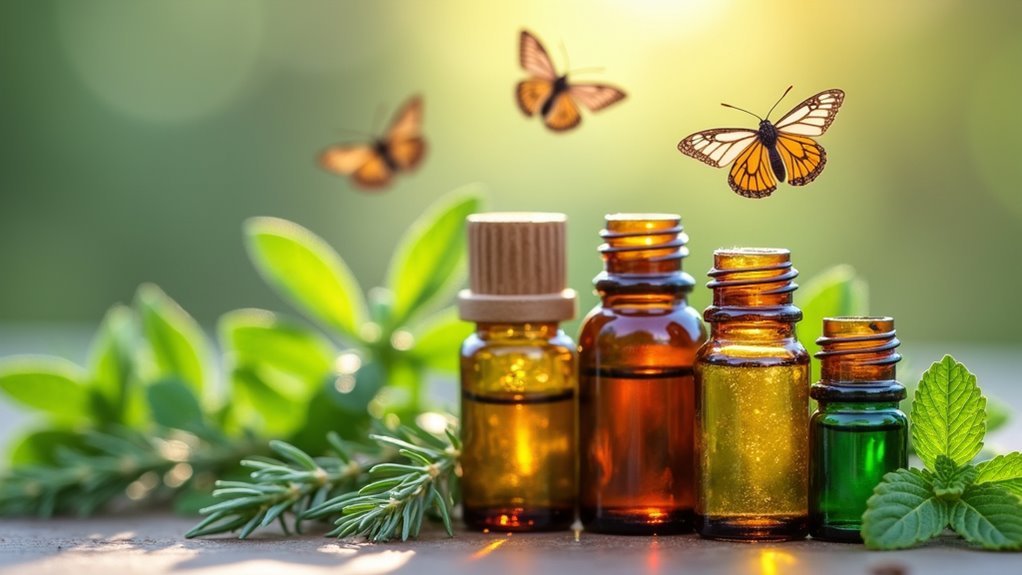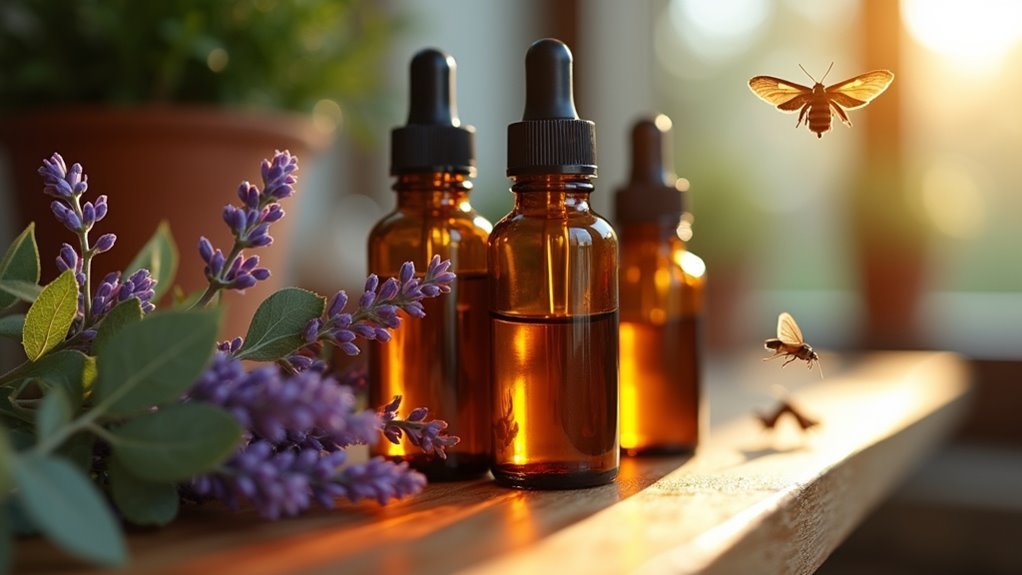Essential oils keep moths away by disrupting their pheromone communication systems, creating sensory overload that prevents them from finding food, mates, and suitable habitats. You’ll find that volatile compounds in oils like cedarwood, lavender, and rosemary scramble moths’ navigation abilities and mask critical scent signals they need for survival. These natural deterrents overwhelm their delicate olfactory systems without harsh chemicals. Understanding which specific oils target different moth species can maximize your protection efforts.
The Science Behind Essential Oil Moth Repellency

When you’re dealing with persistent moth problems, understanding how vital oils work against these pests can help you choose the most effective natural solutions.
Vital oils repel moths through volatile compounds that disrupt their pheromone communication systems. These chemical messengers are critical for moths to locate mates and reproduce, so when you introduce essential oils into their environment, you’re fundamentally scrambling their navigation system.
This pheromone disruption creates an effective moth deterrent that reduces population growth over time. The oils work on multiple levels – not only do they emit scents that moths find unpleasant, but some varieties also possess insecticidal properties that target larvae and eggs.
This dual-action approach makes essential oils a scientifically-backed alternative to synthetic chemical repellents for long-term moth control.
How Aromatic Compounds Disrupt Moth Sensory Perception
When you apply essential oils around moth-prone areas, you’re fundamentally jamming their sophisticated communication network by flooding their environment with competing scents that mask critical pheromone signals.
The aromatic compounds in these oils don’t just create pleasant smells—they actively block the olfactory receptors moths depend on to navigate, find food, and locate mates.
You’ll find that this sensory overload leaves moths confused and unable to perform their basic survival behaviors effectively.
Moth Pheromone Interference Mechanisms
Although moths rely heavily on pheromone detection for survival and reproduction, essential oils containing aromatic compounds can severely disrupt this critical sensory system.
When you use cedarwood or lavender oils, their scent molecules mask the chemical signals female moths emit, preventing males from locating potential mates. These aromatic compounds directly interfere with moths’ olfactory receptors, creating confusion in their navigation and mating behaviors.
You’ll find that specific compounds like linalool in lavender alter moth behavior patterns considerably.
The interference mechanism works by overwhelming their sensory perception, making pheromone traps less effective in treated areas. This disruption leads to decreased mating success and lower moth populations where you’ve applied these natural solutions.
Essential oils effectively deter moths by breaking their fundamental communication system.
Scent Masking Properties
Essential oils create powerful scent barriers that effectively overwhelm moths’ delicate olfactory systems, preventing these insects from detecting the subtle chemical cues they depend on for survival. When you use essential oils to repel moths, you’re fundamentally creating a sensory smokescreen that masks their ability to identify food sources and suitable habitats.
| Essential Oil | Masking Strength | Target Moth Signals |
|---|---|---|
| Cedarwood | High | Food detection cues |
| Lavender | Medium-High | Habitat identification |
| Peppermint | High | Mating pheromones |
| Eucalyptus | Medium | Navigation signals |
| Rosemary | Medium | Territory markers |
These aromatic compounds don’t just deter moths—they completely disrupt their sensory navigation system. You’ll notice moths become disoriented and confused when exposed to these concentrated scents, making them abandon treated areas in search of clearer chemical signals elsewhere.
Olfactory System Disruption
Because moths rely on incredibly sensitive antennae equipped with specialized chemoreceptors to navigate their world, aromatic compounds in crucial oils directly assault these critical sensory organs at the molecular level.
When you introduce cedarwood or lavender oils into your space, you’re fundamentally jamming their biological radar system.
These powerful scents overwhelm moths’ olfactory receptors, preventing them from detecting crucial pheromone signals they need for survival.
The disruption affects three key behaviors:
- Mating communication – Moths can’t locate potential partners
- Food source detection – They lose the ability to find nourishment
- Navigation patterns – Flight becomes erratic and disoriented
This sensory chaos forces moths to flee treated areas, making crucial oils highly effective for repelling moths without harmful chemicals.
Cedarwood Oil: The Most Effective Natural Moth Deterrent
You’ll find cedarwood oil stands out as the most powerful natural moth deterrent because it disrupts their pheromone communication, preventing them from mating and reproducing effectively.
Cedar’s aromatic compounds don’t just repel clothes moths—they also ward off silverfish and carpet beetles while providing a pleasant, natural fragrance that beats harsh chemical mothballs.
You can apply this versatile oil through sachets, cedar blocks, or dryer balls, creating an eco-friendly defense system that requires only periodic renewal to maintain its effectiveness.
Cedar’s Moth-Repelling Properties
When it comes to natural moth deterrents, cedarwood oil stands out as the most powerful weapon in your arsenal against these fabric-damaging pests.
This Cedarwood Essential Oil works by disrupting moths’ pheromone communication systems, effectively sabotaging their ability to mate and reproduce in your storage areas.
The aromatic compounds create an environment that moths find unbearable, making it an excellent Moth Repellent without toxic chemicals.
Research confirms that cedarwood’s scent considerably reduces moth activity and prevents infestations.
You can maximize cedar’s effectiveness by:
- Combining it with lavender and rosemary oils for enhanced protection
- Using cedar blocks, balls, or oil-infused sachets in storage spaces
- Applying the oil directly to storage containers for long-lasting defense
Application Methods for Cedar
Understanding cedarwood’s powerful moth-repelling properties is only half the battle – applying it correctly determines your success in protecting fabrics from these persistent pests.
You can place cedar sachets or wooden blocks directly in closets, drawers, and storage areas where moths typically target natural fibers.
Add cedarwood essential oils to dryer balls during laundry cycles to infuse your fabrics with protective scent while they dry.
For enhanced protection, apply cedar oil to moth-proof storage bags before sealing seasonal clothing.
Remember to refresh your cedar applications regularly since the scent diminishes over time.
Combine these methods with routine cleaning and moth traps to create a thorough defense system against clothes moths.
Lavender Essential Oil for Pleasant Moth Protection

While many chemical moth repellents can overwhelm your senses with harsh odors, lavender oil offers a naturally fragrant solution that’s both effective and enjoyable.
You’ll find that lavender oil disrupts moth pheromones, making it nearly impossible for these pests to locate mates and reproduce successfully.
Here are three effective ways to use lavender oil to keep moths away:
- Create sachets filled with dried lavender or cotton balls soaked in lavender oil for your closets
- Add several drops to wool dryer balls and place them in storage areas
- Apply fresh lavender oil to existing sachets monthly for maximum effectiveness
This versatile essential oil doesn’t just target clothes moths – it repels various household pests, making it an excellent multi-purpose solution for your home’s pest management needs.
Rosemary Oil Benefits for Pantry and Kitchen Areas
You’ll find rosemary oil particularly effective against pantry moths because its strong scent disrupts their pheromones and prevents egg-laying in your storage areas.
The active compounds like camphor and rosmarinic acid naturally repel insects without harsh chemicals, making it perfect for kitchen use.
You can easily apply this versatile oil by mixing it with water for surface spraying or placing dried rosemary sachets directly in your pantry containers.
Pantry Moth Deterrent Properties
Three key properties make rosemary essential oil exceptionally effective against pantry moths in your kitchen spaces.
When you’re looking for essential oils for moth control, rosemary stands out due to its unique pantry moth deterrent properties that target these pests naturally.
The oil’s strong aromatic compounds work through these mechanisms:
- Pheromone disruption – The intense scent interferes with moths’ ability to locate food sources and communicate with mates
- Antimicrobial protection – Keeps your stored foods fresher while preventing contamination from moth larvae and bacteria
- Non-toxic safety – You can use it around food, children, and pets without health concerns
You’ll find rosemary oil particularly effective when applied to cotton balls or sachets placed strategically throughout your pantry.
This creates continuous protection that complements proper food storage practices.
Kitchen Application Methods
Understanding rosemary oil’s deterrent properties helps you implement effective application methods throughout your kitchen and pantry areas.
You can apply rosemary essential oil to cotton sachets or wooden blocks, then place them strategically on pantry shelves and inside kitchen cabinets. This creates natural barriers that pantry moths won’t cross.
The pleasant rosemary aroma enhances your kitchen’s scent while providing protection. You’ll need to replenish the oil regularly to maintain efficacy against moths.
For stronger results, combine rosemary with other essential oils like lemon or thyme. This multi-faceted approach maximizes your moth prevention efforts.
Simply refresh your sachets or blocks every few weeks to guarantee continuous protection throughout your food storage areas.
Lemon and Bergamot Oils for Multi-Purpose Pest Control

While most essential oils target specific pests, lemon and bergamot oils deliver extensive protection against moths and various other insects.
These citrus-based essential oils serve as powerful deterrent moths solutions while offering additional benefits throughout your home.
Lemon oil’s limonene compound creates an unwelcoming environment for moths while providing antibacterial properties for surface cleaning.
Bergamot oil’s uplifting scent enhances moth protection when combined with other oils, creating thorough pest control solutions.
Key applications include:
- Creating sprays and sachets for clothing storage areas
- Adding oils to cleaning routines for kitchen and pantry protection
- Combining with other essential oils for enhanced effectiveness
You’ll need to replenish these oils regularly in storage areas to maintain ongoing protection while keeping your home fresh and moth-free.
Differences Between Clothes Moth and Pantry Moth Repellents
Different moth species require targeted approaches with specific essential oils to achieve effective protection in your home.
You’ll need cedarwood, lavender, and bergamot essential oils for clothes moths, as these disrupt their pheromones while providing pleasant scents.
For pantry moths, rosemary, thyme, lemon, and sage oils work best to repel them from food sources.
Application methods also differ considerably.
Place cedarwood and lavender oils in sachets or on wooden blocks to protect textiles from clothes moths.
For pantry moths, use rosemary and lemon oils in spray form on food storage surfaces.
Cedarwood stands out as the most effective natural repellent for clothes moths, while rosemary excels against pantry moths.
Each approach targets specific moth behaviors and habitats for ideal results.
Safe Application Methods for Essential Oil Moth Prevention
Proper application techniques guarantee your essential oils remain effective while protecting your belongings from potential damage.
Never apply oils directly onto clothing or food items, as this creates sticky residue and potential staining. Instead, use indirect methods that maintain the oils’ moth prevention properties without compromising your possessions.
Avoid direct oil application on fabrics and food to prevent staining while preserving moth-repelling effectiveness through safer indirect methods.
For best results, consider these safe application approaches:
- Apply essential oils to sachets, wooden blocks, or dryer balls that you’ll place near vulnerable items
- Create DIY spray solutions mixing oils with water for surrounding areas, avoiding direct textile contact
- Combine oils with moth-proof storage bags to enhance protective capabilities
You’ll need to replenish oils every few weeks to maintain effectiveness.
This strategic placement ensures continuous moth prevention while keeping your belongings safe from oil-related damage.
Creating DIY Moth Repellent Sachets and Dryer Balls
You can create powerful moth deterrents by making your own essential oil sachets and dryer balls using simple household materials.
These DIY solutions offer a natural, chemical-free way to protect your clothes while adding pleasant fragrances to your storage areas and laundry.
Both methods work effectively when you use the right essential oils and maintain them properly for long-lasting moth protection.
Essential Oil Sachets
Three simple ingredients can transform your moth prevention strategy when you create DIY essential oil sachets and dryer balls.
You’ll need cedarwood, lavender, or rosemary essential oils combined with natural materials like rice or dried herbs, then placed in breathable fabric pouches. These sachets allow the scent to permeate your storage areas effectively.
For dryer balls, add several drops of essential oils directly onto wool dryer balls to infuse your laundry with moth-repelling scents during the drying process.
Key benefits of essential oil sachets include:
- Non-toxic and eco-friendly alternative to chemical repellents
- Safe for use around children and pets
- Cost-effective and customizable scent combinations
Remember to refresh your essential oils every few weeks to maintain their effectiveness against moths in your home.
Moth-Repelling Dryer Balls
While essential oil sachets offer excellent protection in storage areas, moth-repelling dryer balls take your defense strategy directly into the laundry room where many moth problems begin.
You can infuse dryer balls with essential oils like cedarwood, lavender, or rosemary to naturally deter moths while adding pleasant scents to your laundry. These versatile balls don’t just combat moth problems—they also reduce drying time and static buildup.
Apply essential oils directly to the dryer balls rather than your clothing to prevent staining or stickiness on fabrics.
Remember to refresh the oils regularly to maintain their effectiveness. This dual-purpose approach guarantees your clothes emerge moth-free and beautifully scented while maximizing your laundry routine’s efficiency.
Advantages Over Chemical Pesticides and Sprays
When considering moth control options, essential oils offer compelling advantages that make them superior to conventional chemical pesticides and sprays.
You’ll find that essential oils provide effective moth deterrence while prioritizing your family’s health and well-being.
The benefits of choosing essential oils over chemical pesticides include:
- Safety for your household – Essential oils are non-toxic and pose no health risks to pets or children, unlike harsh chemical alternatives
- Pleasant aromatherapy experience – Cedarwood and lavender oils create appealing scents throughout your home instead of overwhelming chemical odors
- Cost-effective prevention – You can easily create DIY repellents and sachets, eliminating repeated pesticide purchases
Essential oils like cedarwood and rosemary effectively disrupt moth pheromones while supporting a natural, preventative approach to pest control when combined with regular cleaning.
Combining Essential Oils With Proper Storage Techniques
To maximize your moth prevention strategy, you’ll want to pair essential oils with smart storage practices that create an impenetrable barrier against these fabric-destroying pests. Combining cedarwood and lavender oils with airtight containers provides dual protection by repelling moths while blocking access to stored items. You’ll enhance effectiveness by regularly replenishing essential oils and using vacuum-sealed bags to eliminate larvae and eggs. Adding oil-infused sachets creates pleasant scents while deterring pests.
| Storage Method | Essential Oil | Protection Level |
|---|---|---|
| Airtight containers | Cedarwood + Lavender | Maximum |
| Vacuum-sealed bags | Any preferred oil | High |
| Sachets in drawers | Lavender | Medium |
| Cedar blocks | Cedarwood | Medium |
| Open storage | Multiple oils | Low |
Proper storage techniques require dry, well-ventilated areas that minimize moth-favorable conditions.
Maintaining Oil Potency for Long-Term Effectiveness
Since essential oils naturally degrade over time, you’ll need a consistent maintenance routine to keep your moth protection working effectively.
Maintaining oil potency requires strategic storage and regular renewal to guarantee lasting moth deterrence.
Strategic storage and consistent oil renewal are essential for maintaining effective moth deterrent potency over time.
Store your essential oils properly by keeping them in cool, dark locations away from sunlight. Heat and light break down the active compounds that repel moths, reducing their effectiveness considerably.
Follow these key maintenance practices:
- Replenish sachets and cedar blocks every few weeks with fresh essential oils to maintain their protective strength
- Use only high-quality, pure oils as synthetic versions lose potency faster and provide weaker moth protection
- Renew cedar wood annually with essential oil treatments, since cedar absorbs oils over time
Consider blending different essential oils together for enhanced potency against various moth species.
Essential Oil Quality Factors for Maximum Pest Control
Beyond proper storage and renewal practices, the quality of your essential oils directly determines how well they’ll protect against moths.
You’ll want to source quality essential oils from reputable suppliers who provide detailed information about extraction methods and botanical origins. These suppliers guarantee their products are free from additives and fillers that can reduce effectiveness.
Look for oils from first distillation processes, as they preserve the most potent compounds that deter moths.
Purity and concentration are vital – higher quality essential oils contain stronger active compounds that create better pest control.
Consider organic certification as an indicator of superior products, since these oils are produced without synthetic chemicals that can diminish their natural moth-repelling properties.
When to Use Essential Oils Versus Professional Moth Traps
While essential oils excel at preventing moth problems before they start, professional moth traps serve a different purpose by actively targeting existing infestations.
You’ll want to use essential oils like cedarwood and lavender as your first line of defense, creating aromatic barriers in closets and storage areas to deter moths from entering.
However, when you notice moth activity or infestation signs, moth traps become your go-to solution. These traps use pheromones to attract and capture male moths, breaking their breeding cycle.
For ideal results, consider this strategic approach:
- Use essential oils for ongoing prevention in moth-vulnerable areas
- Deploy moth traps when you spot active moth presence
- Combine both methods for all-encompassing protection and population control
Frequently Asked Questions
Do Essential Oils Repel Moths?
Yes, you’ll find essential oils effectively repel moths by disrupting their pheromones. You can use cedarwood, lavender, or rosemary oils in sachets, sprays, or dryer balls for natural, non-toxic moth control.
What Smell Do Moths Hate the Most?
Moths hate cedarwood’s scent the most since it disrupts their pheromones completely. You’ll find cedar essential oil extremely effective at deterring clothing moths. Lavender, rosemary, and citrus scents also repel them greatly.
Why Does Lavender Repel Moths?
Lavender repels moths because it contains linalool and linalyl acetate compounds that disrupt their behavior. When you use lavender oil, these natural chemicals interfere with moths’ sensory systems, making them avoid treated areas.
What Is the Most Effective Moth Deterrent?
Cedarwood essential oil’s your most effective moth deterrent since it disrupts moth pheromones and specifically repels Clothes Moths. You’ll find it works better than other options, though combining it with moth traps enhances effectiveness.
In Summary
You’ve learned how essential oils naturally repel moths through aromatic compounds that disrupt their sensory systems. Cedarwood provides the strongest protection, while lavender adds pleasant fragrance to your spaces. Don’t forget to combine oils with proper storage techniques and maintain their potency through quality products. You’ll find essential oils work best for prevention, but you should consider professional traps for existing infestations. Start protecting your belongings with these natural solutions today.





Leave a Reply